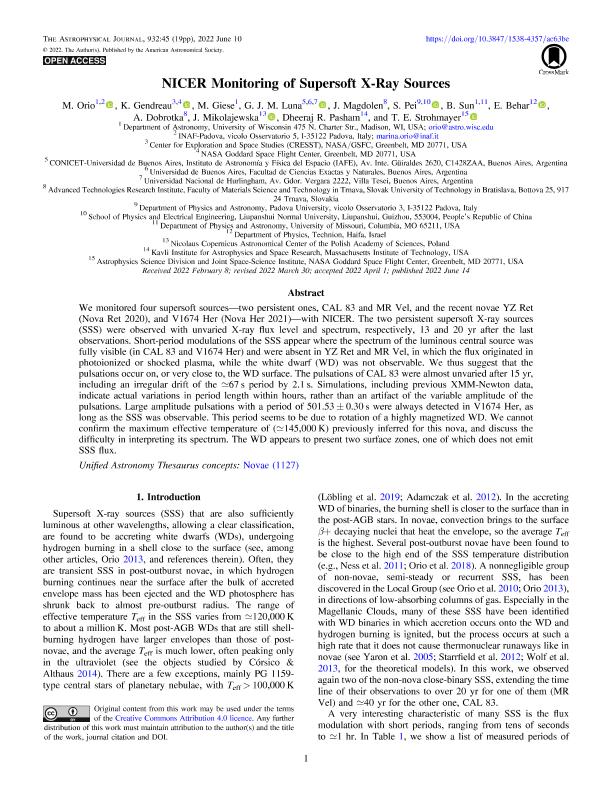Mostrar el registro sencillo del ítem
dc.contributor.author
Orio, M.
dc.contributor.author
Gendreau, K.
dc.contributor.author
Giese, M.
dc.contributor.author
Luna, Gerardo Juan Manuel

dc.contributor.author
Magdolen, J.
dc.contributor.author
Pei, S.
dc.contributor.author
Sun, B.
dc.contributor.author
Behar, E.
dc.contributor.author
Dobrotka, A.
dc.contributor.author
Mikolajewska, J.
dc.contributor.author
Strohmayer, T. E.
dc.date.available
2023-10-12T14:55:21Z
dc.date.issued
2022-07
dc.identifier.citation
Orio, M.; Gendreau, K.; Giese, M.; Luna, Gerardo Juan Manuel; Magdolen, J.; et al.; NICER Monitoring of Supersoft X-Ray Sources; IOP Publishing; Astrophysical Journal; 932; 1; 7-2022; 45-64
dc.identifier.issn
0004-637X
dc.identifier.uri
http://hdl.handle.net/11336/215032
dc.description.abstract
We monitored four supersoft sources - two persistent ones, CAL 83 and MR Vel, and the recent novae YZ Ret (Nova Ret 2020), and V1674 Her (Nova Her 2021) - with NICER. The two persistent supersoft X-ray sources (SSS) were observed with unvaried X-ray flux level and spectrum, respectively, 13 and 20 yr after the last observations. Short-period modulations of the SSS appear where the spectrum of the luminous central source was fully visible (in CAL 83 and V1674 Her) and were absent in YZ Ret and MR Vel, in which the flux originated in photoionized or shocked plasma, while the white dwarf (WD) was not observable. We thus suggest that the pulsations occur on, or very close to, the WD surface. The pulsations of CAL 83 were almost unvaried after 15 yr, including an irregular drift of the ≃67 s period by 2.1 s. Simulations, including previous XMM-Newton data, indicate actual variations in period length within hours, rather than an artifact of the variable amplitude of the pulsations. Large amplitude pulsations with a period of 501.53 ± 0.30 s were always detected in V1674 Her, as long as the SSS was observable. This period seems to be due to rotation of a highly magnetized WD. We cannot confirm the maximum effective temperature of (≃145,000 K) previously inferred for this nova, and discuss the difficulty in interpreting its spectrum. The WD appears to present two surface zones, one of which does not emit SSS flux.
dc.format
application/pdf
dc.language.iso
eng
dc.publisher
IOP Publishing

dc.rights
info:eu-repo/semantics/openAccess
dc.rights.uri
https://creativecommons.org/licenses/by-nc-sa/2.5/ar/
dc.subject
novae
dc.subject.classification
Astronomía

dc.subject.classification
Ciencias Físicas

dc.subject.classification
CIENCIAS NATURALES Y EXACTAS

dc.title
NICER Monitoring of Supersoft X-Ray Sources
dc.type
info:eu-repo/semantics/article
dc.type
info:ar-repo/semantics/artículo
dc.type
info:eu-repo/semantics/publishedVersion
dc.date.updated
2023-10-11T15:00:35Z
dc.journal.volume
932
dc.journal.number
1
dc.journal.pagination
45-64
dc.journal.pais
Reino Unido

dc.journal.ciudad
Londres
dc.description.fil
Fil: Orio, M.. Istituto Nazionale di Astrofisica; Italia
dc.description.fil
Fil: Gendreau, K.. National Aeronautics and Space Administration; Estados Unidos
dc.description.fil
Fil: Giese, M.. University of Wisconsin; Estados Unidos
dc.description.fil
Fil: Luna, Gerardo Juan Manuel. Consejo Nacional de Investigaciones Científicas y Técnicas. Oficina de Coordinación Administrativa Ciudad Universitaria. Instituto de Astronomía y Física del Espacio. - Universidad de Buenos Aires. Facultad de Ciencias Exactas y Naturales. Instituto de Astronomía y Física del Espacio; Argentina
dc.description.fil
Fil: Magdolen, J.. Slovak Academy of Sciences. Institute of Botany; Eslovaquia
dc.description.fil
Fil: Pei, S.. Università di Padova; Italia
dc.description.fil
Fil: Sun, B.. University of Missouri; Estados Unidos
dc.description.fil
Fil: Behar, E.. Technion - Israel Institute of Technology; Israel
dc.description.fil
Fil: Dobrotka, A.. Slovak Academy of Sciences. Institute of Botany; Eslovaquia
dc.description.fil
Fil: Mikolajewska, J.. Nicolaus Copernicus Astronomical Center of the Polish Academy of Sciences; Polonia
dc.description.fil
Fil: Strohmayer, T. E.. No especifíca;
dc.journal.title
Astrophysical Journal

dc.relation.alternativeid
info:eu-repo/semantics/altIdentifier/url/https://iopscience.iop.org/article/10.3847/1538-4357/ac63be
dc.relation.alternativeid
info:eu-repo/semantics/altIdentifier/doi/http://dx.doi.org/10.3847/1538-4357/ac63be
Archivos asociados
